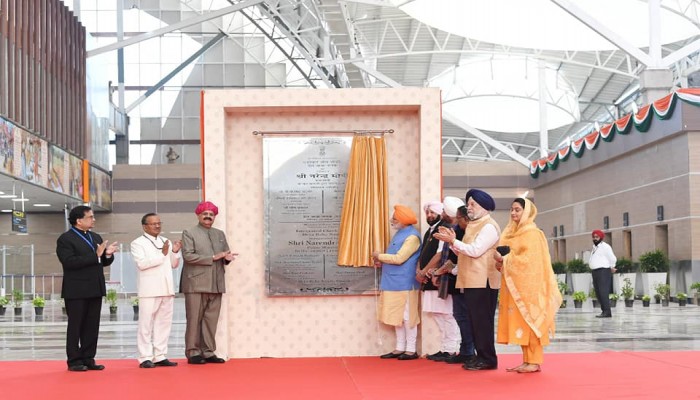India’s Kartarpur Conundrum and how to deal with Pakistan
- In Foreign Policy
- 11:11 AM, Nov 12, 2019
- Ramaharitha Pusarla
Right from the day one Pakistan’s overt enthusiasm to resurrect India’s long pending plea of providing access to Darbar Sahib Gurudwara in Kartarpur had treachery, deceit and lies written all over it. Kartarpur barely 4 km from Indian border in the Narowal District, of Pakistan’s Punjab Province has the abode of Guru Nanak Dev who spent last 18 years of his life. Kartarpur stands as a towering example of blunders of partition where a randomly drawn Radcliff line denied millions of Sikhs an access to their sacred place. Barely a stone-throw away from the Indian border, Sikhs till now were contended by the mere glance of the Darbar Sahib through a high-powered telescope from the Indian side.
In 1999 Atal Bihari Vajpayee on his Lahore bus ride requested Pakistan to provide access to Kartarpur. Last year, the elected Prime Minister Imran Khan, during his swearing in ceremony communicated Pakistan’s plans of working on India’s long pending plea through its catspaw Navjot Singh Sidhu who attended the event. Foisting it as a good will gesture at the behest of his ISI masters, Khan has successfully pushed this agenda. Losing no time, aman ki asha brigade and the Western media loaded with pro-Pakistani lobbyists pushed Pakistani agenda as a religious diplomacy with a potential to bring about peace and harmony between two countries.
Commemorating 550th birth anniversary of Guru Nanak Dev, the following year, Indian government mindful of Pakistan’s nefarious tactics approved the construction of Kartarpur corridor. Modi government even dispatched Union Ministers to participate in the foundation stone laying ceremony. Shadowing presence of the Army General Qamar Bajwa and Khalistan rebel Gopal Singh Chawla at the foundation stone ceremony at Kartarpur confirmed India’s doubts of revival ISI’s diabolical agenda of Kashmir and Khalistan (K2). Veiling, precocious crafty mechanisations in the background, Khan overtly used this occasion to burnish Pakistan’s international credentials as a peace maker in South Asia.
Known for its characteristic subterfuge, determined to draw mileage from the Kartarpur corridor, allaying Indian fears Pakistan made tall proclamations of keeping the pro-Khalistani groups at bay. Under the ruse of orchestrated religious diplomacy, Pakistan anticipated to open a channel of communication with India and initiate peace talks. On the contrary, Indo-Pakistan relations have touched rock bottom with countries coming close to a fourth war in the wake of Pulwama attacks and Balakot retaliation. As matters worsened countries even closed air space and halted the LoC trade. Abrogation of article 370 in August was the final nail in coffin. Khan openly declared himself as Kashmiri ambassador and kicked Pakistani international media blitzkrieg. Needless to say, Pakistan’s brazen anti-Indian agenda became more obvious.
Notwithstanding the burden on the economy, Pakistan timed the corridor in the context of Canadian elections and US-based Sikh for Justice (SFJ)’s sham Referendum 2020. Indeed, weeks ahead of the final agreement on the operationalisation of the Kartarpur corridor, Pakistan was caught air dropping cache of arms, fake currency and ammunition using Chinese drones in the bordering districts of Punjab. Indian agencies busted terror module Khalistan Zindabad Force (KZF) working at the instructions of deep state to create unrest through series of strikes in Punjab and adjoining regions. Having failed to unleash terror in Kashmir, which is turned into a fortress in the aftermath of article 370 revocation, ISI opened the Punjab frontier. Amidst the provocations and censure from analysts of “political expediency” having given word, Indian leadership didn’t back out.
On October 24th after several three rounds of tough negotiations, India and Pakistan signed the final agreement for operationalisation of Kartarpur corridor at the Zero point along the international border. Across the world, Gurudwaras are known to provide free access and food for pilgrims. Much against the true spirit of the religion, Pakistan obstinately stuck to point to charging $20 from every Indian Sikh pilgrim for single trip. Charade of Pakistan’s touted religious diplomacy was exposed once again after it refused to do away with the service fee. Barely less than a week before opening of the corridor which connects Dera Baba Nanak in Punjab to Darbar Shahib, Indian intelligence agencies received reports of anti-India terror agencies moving to areas close to Kartarpur.
The erosion of Pakistan’s illusionary good will hit a new low after Pakistan’s official video commemorating the opening of the corridor carried the images of the slain Khalistani trio-Jarnail Singh Bhindranwale, Amrik Singh Khalsa and Maj Gen Shabej Singh killed in the Operation Blue Star at the Golden Temple in 1984. Blatantly projecting its intentions, Pakistan made no secret of its agenda of reigniting the Khalistan movement under the façade of the respecting the religious sentiments of Sikhs. Unsurprisingly, it has even created confusion regarding the modalities by unilaterally making amends in the operational details. Undermining the bilateral agreement, Pakistan failed to clear and confirm the first list of the travellers four days of the travel as agreed. It didn’t share even the details of the security and medical facilities. Compounding this confusion, to gain brownie points, Imran Khan tweeted that Kartarpur pilgrims can travel with any valid ID and exempted the service fee for travellers on the opening day and Guru Purb. But the office of ISPR quickly overturned Khan’s grandiose declarations. Conflicting messaging by Pakistan’s civil and military officials and inconsistencies fuelled more suspicions. Military officials insisted on entry with passports as it planned to create a database of pilgrims.
Cognizant of strategic vulnerabilities, on November 9th Prime Minister Modi inaugurated the Kartarpur corridor on the Indian side and flagged off first jatha of over 500 people. An overwhelmed SGPC (Shirmani Gurudwara Prabhandak Committee) conferred Qaumi Seva award on Modi for the audacious decision replete of risks. Modi thanked Imran Khan Niazi (apparent dig) for respecting the religious sentiments. Pakistan offered to provide access to Kartarpur corridor even during Congress regime. But it didn’t respond.
Pakistan’s penchant for instigating Sikhs is evident from the signboard within the Gurudwara claiming that Indian Air Force targeted the Darbar Sahib during the 1971 war. Ignoring the provocations, Modi government pursued the corridor to offer a healing to Sikhs. Sikhs have been at the receiving end. They bore the brunt of inhuman brutality during the bloody partition paying with their lives and the events of 1984 have sowed the seeds of dissension and mistrust. Having survived a near genocide offering a closure to 1984 and providing access to places of religious significance could restore some faith in Sikhs who stood up for Hindus and persecuted Kashmiris towards India. For decades, Pakistan has been exploiting India’s fault lines to foster its anti-India agenda to the hilt. With this historic initiative fraught with challenges, Indian leadership walked an extra mile to reach out to the Sikh community. Given the religious and spiritual salience of this pilgrimage, this iconic day will now become immensely important for the Sikh community as well.
Pakistan anticipated a spectacular media coverage and an overwhelming gush of opeds adorning the international media from the sympathetic western media for its beguiling peace initiative. Khan’s high hopes of hogging headlines dashed as Supreme Court of India pronounced historic judgement on Ayodhya temple just hours ahead of the Kartarpur corridor and the attention of media shifted to the most happening place, New Delhi.
Pakistan’s religious diplomacy is a pernicious plot replete of security threats with an indubitable promise of reviving Khalistan movement. But having committed itself, India has no two ways except tightening vigil and adopting extreme caution.
Disclaimer: The opinions expressed within this article are the personal opinions of the author. MyIndMakers is not responsible for the accuracy, completeness, suitability, or validity of any information on this article. All information is provided on an as-is basis. The information, facts or opinions appearing in the article do not reflect the views of MyindMakers and it does not assume any responsibility or liability for the same.







Comments